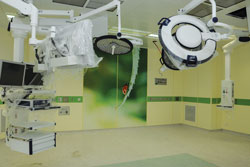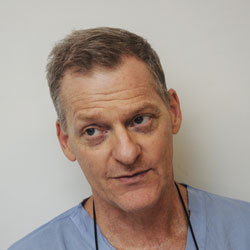Health + Medicine
Feature
Center of Operations

It’s like stepping into a science-fiction cliché. The elevator glides silently down through Jerusalem’s bedrock. Four stories belowground, the doors slide open to reveal a vast subterranean complex. Dozens of rooms, bristling with high-tech devices, lead off a long L-shaped corridor. There is muted beeping. Lights flash red, green and blue. Doors open at a touch.
The many monitors are familiar—but not so the articulated arms studded with ports and sockets descending from the ceilings.
Welcome to the new Surgical Center, part of the Sarah Wetsman Davidson Hospital Tower at the Hadassah Medical Center in Jerusalem, scheduled to open in December. “It [is] the best surgical facility in Israel and ranks with the best in the world,” says Dr. Ofer Gofrit, a senior Hadassah urologist who heads the committee that planned this new integrated surgical environment. “Despite the speed at which surgery and surgical technologies are advancing, we are confident it will remain that way for at least a generation to come.”
The new facility has broken with the standard operating room developed in the 1940s and used ever since. That design was about creating space for multiple surgeries at the same time. While a definite step up from the amphitheaters of a century earlier (hence, operating “theater”), where spectators watched surgeons at work, aprons protecting their street clothes from the blood, it is totally inadequate for the incorporation of new computers and machinery.
“Modern surgery is sophisticated and technology-rich,” says Dr. Gofrit. “Robotics, computer-assisted navigation and imaging are routine in major medical centers. Hadassah uses them all—in fact, we have played a major role in developing several, and we are known for our oncology, trauma, minimally invasive and robotic surgery.”

Hadassah surgeons, physicians, nurses and social workers, together with architects, engineers and many others, have all had input in developing the new complex. They have brought their own experience as well as studied operating facilities and systems worldwide. They have pinpointed Hadassah’s areas of surgical excellence, mapped future directions and explored developing surgical strategies, technologies and procedures.
“We looked at our everyday needs, tried to anticipate those of the future and worked to address them all,” sums up Dr. Gofrit. “With surgical techniques and instruments in rapid development, flexibility is a canon of the new Surgical Center. We are building an infrastructure that will accommodate tools as they are developed—from those now in design to those not yet thought of.”
Flow through the new facility is carefully thought out. The 20 ORs (13 will be ready for immediate use), which are the heart of the complex, are supported by pre-op, step-down and recovery units, scrub sinks and sterile supply, offices and workstations, staff lounges and family waiting rooms, conference and seminar rooms as well as banks of elevators that will ferry patients to and from the wards in the tower above. With the entire complex built to be resistant to conventional and unconventional attacks, its 60 pre- and post-op beds (among them, intensive care and isolation beds) can be instantly transformed into a secure underground hospital.
Porous plaster walls belong to the ORs of the past. In the new complex, walls are large durable steel panels that eliminate reflection and glare, meet stringent hygiene requirements, shield against X-ray and protect against fire. Painted in creams and pastels, they look little different from traditional walls, but lend themselves to an unexpected addition: In each OR, two huge panels are pictures. In one, a ladybug rests on a blade of grass. In others, a water drop is caught as it splashes into water, yellow sunflowers nod, pink thistles blush, a blue dragonfly buzzes and a green frog frolics. Held in a frame of floor and ceiling rails between vertical supports, the panels can be reconfigured or slid open to reach the utility lines behind them.
Lighting, too, has had a 21st-century upgrade. Three state-of-the-art light cupolas (two of them 120 watt and one 80 watt) with flexible three-color combinations allow surgeons to change the type and degree of illumination without generating shadows or overheating. For minimally invasive procedures, when surgeons watch their work on a screen, there are red, green or blue views, which are bright enough for reading and note-taking and will not blind the surgeon.
The multimedia hub of each OR is suspended from its ceiling: four booms, each supporting a workstation—for the anesthesiologist, assistant anesthesiologist, surgeon and nurse. Workstations are equipped as needed—with high-tech hardware for robotic, laparoscopic and computer-assisted surgery, suction, gas and infusion systems, light sources, insufflators, electrosurgical units, smoke evacuators and compression devices—their thick cables and suction tubes snaking through conduits and raceways above removable, washable ceiling panels.
In the old surgical suite, much of this equipment is on the floor or wheeled in on trolleys, the cables stretching hazardously across the floor, as development outpaced the facility.
Digital cameras and flat-screen monitors are also suspended from the booms. “Every OR has computers, video and telecommunications equipment to store, retrieve and manipulate data,” says Dr. Yoram Weiss, Hadassah’s head of anesthesiology, who has been involved in two previous surgical moves in different hospitals. “Surgeons will see all relevant data displayed on a single monitor as they operate, from the patient’s file [CTs, X-rays, ultrasound scans and lab results] to real-time images from surgical microscopes and endoscopic cameras—these latter automatically entered into the file with the anesthesia data.”
All but two of the new complex’s 20 ORs, each with a price tag of over $1 million, are built to the same basic design, with minor modifications to accommodate different specialties. Neurosurgery, for example, has its own ceiling configuration; trauma and orthopedic surgery are larger; cardiac surgery has more screens and electrical sockets. The other two ORs (one of them coming into immediate use) will each cost double that. These are the hybrid operating rooms. At the vanguard of medical technological innovation, they areequipped for any and all of the multitude of futuristic surgical procedures—digital intraoperative diagnostics and imaging, catheterization, interventional therapies combined with open surgery, minimally invasive surgery, endovascular procedures as well as emerging areas.
“Hybrid ORs are the surgical future, giving maximum versatility and allowing us to perform virtually any surgical procedure,” explains Dr. Alon J. Pikarsky, acting head of Hadassah’s surgical division. Hadassah’s first hybrid OR has Israel’s only Artis Zeego multiaxis imaging system. The machine combines industrial robotics technology with imaging systems, enabling both anatomy and diseases to be visualized from all sides with unprecedented precision.
“We are training in its use,” says Dr. Gofrit. “One thing we quickly learned is that the system rotates around the patient at such speed that we need a no-fly zone around it!”
As well as reequipping and redesigning, Hadassah’s surgical team is using its move to the tower to reexamine and improve its performance. With time a severely limited and very costly resource in the OR, ways have been created to use it more efficiently. Patients will no longer be prepped in the OR, for example, but in the new 20-bed pre-op area—two of these beds, designated for more severe patients, in a separate section.
With only weeks to go before the long-anticipated move, Hadassah’s surgical team is energized and eager. “We are moving not simply from one building to another,” says Dr. Gofrit. “We are moving into the surgical future.”








 Facebook
Facebook Instagram
Instagram Twitter
Twitter
Leave a Reply